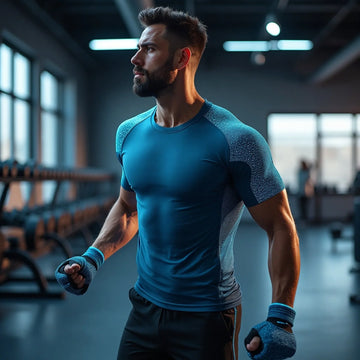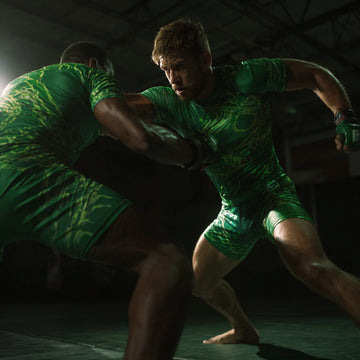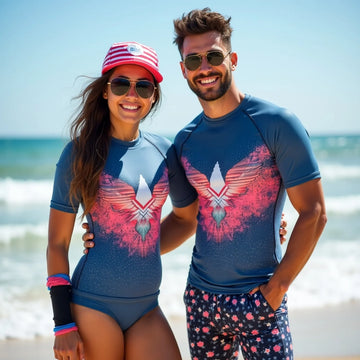Introduction to Adaptive Compression Technology
Snippet-bait definition: Adaptive compression rash guards are smart sportswear that adjust pressure dynamically to your muscles’ fatigue levels, boosting performance and speeding recovery as you move.
Imagine a rash guard that doesn’t just hug your body but actually listens to your muscles. Sounds like sci-fi? Well, welcome to 2025, where adaptive compression rash guards are reshaping athletic wear. These garments go beyond static compression—they respond in real time to muscle fatigue, tweaking pressure to support your body exactly when it needs it most.
Adaptive compression technology is the next step in smart sportswear, blending biomechanics with sensor tech to create gear that’s almost like a second skin with a brain. Instead of one-size-fits-all pressure, these rash guards dynamically adjust, helping athletes push harder and recover faster.
Whether you’re a weekend warrior or a pro grappler, this tech is designed to keep you in the game longer and feel fresher after every session.
How Muscle Fatigue Affects Performance
Muscle fatigue isn’t just about feeling tired—it’s a complex physiological process that can seriously hamper your performance. When muscles tire, their ability to contract efficiently drops, coordination falters, and injury risk spikes. That’s why managing fatigue is crucial for athletes of all levels.
Here’s the kicker: traditional compression gear offers uniform pressure, which can help circulation but doesn’t adapt as your muscles tire or recover. Enter the muscle fatigue rash guard, designed to sense these changes and respond accordingly.
By targeting fatigued muscle groups with increased compression, these rash guards help reduce lactic acid buildup and improve blood flow, effectively giving your muscles a helping hand when they start to flag.
Technology Behind Adaptive Rash Guards
So, how do these smart rash guards actually work? At their core, they combine advanced compression fabrics with embedded sensors that monitor muscle activity in real time. These sensors track electrical signals and muscle vibrations, feeding data to microcontrollers woven into the fabric.
When the system detects signs of fatigue, it triggers subtle adjustments in compression zones—tightening or loosening specific areas to optimize support. This isn’t guesswork; it’s precise, responsive engineering.
For a detailed look at compression rash guard technology, check out some of the latest models that showcase this blend of textile innovation and wearable tech.
Benefits of Rash Guards That Respond to Muscle Fatigue
Why bother with adaptive compression? Because the benefits go beyond just looking cool in your gear. Here’s what these rash guards bring to the table:
- Enhanced Performance: By supporting fatigued muscles in real time, you can maintain power and endurance longer.
- Faster Recovery: Improved blood flow helps clear metabolic waste, reducing soreness post-exercise.
- Injury Prevention: Dynamic compression stabilizes muscles and joints, lowering the risk of strains.
- Comfort & Fit: Adaptive pressure means no more “cutting off circulation” or sagging fabric.
- Versatility: Suitable for a range of sports, from grappling to running and cycling.
These benefits are why athletes are increasingly turning to rash guards with compression technology that actively respond to their body’s needs rather than static garments.
Comparing Adaptive Compression Rash Guards to Traditional Ones
| Feature | Traditional Compression Rash Guards | Adaptive Compression Rash Guards |
|---|---|---|
| Compression Type | Static, uniform pressure | Dynamic, adjusts in real time |
| Muscle Fatigue Response | None | Monitors and adapts to fatigue levels |
| Recovery Support | Basic circulation aid | Enhanced blood flow targeting fatigued areas |
| Comfort | Can feel restrictive or loose over time | Customizes fit during activity |
| Technology Integration | Minimal or none | Embedded sensors and microcontrollers |
Use Cases and Athlete Testimonials
Adaptive compression rash guards are already making waves across multiple sports. Grapplers appreciate the muscle support during long training sessions, while runners notice less fatigue on those brutal uphill stretches. Even youth athletes benefit, with rash guards for kids incorporating scaled-down versions of this tech to protect young muscles.
Wrestlers swear by the combination of compression and flexibility offered by gear like the wrestling singlet designed with adaptive features, helping them stay sharp and reduce downtime from injuries.
Here’s the thing: athletes aren’t just wearing these rash guards—they’re experiencing tangible differences in how their bodies respond during and after workouts.
How to Choose the Right Adaptive Compression Rash Guard
Picking the perfect adaptive compression rash guard isn’t just about style or brand. Here’s what to keep in mind:
- Sensor Accuracy: Look for rash guards with reliable, well-tested muscle fatigue monitoring systems.
- Material Quality: Breathable, moisture-wicking fabrics are a must for comfort during intense sessions.
- Fit & Flexibility: The garment should move with you, not against you, adapting to your range of motion.
- Durability: Check for reinforced stitching and abrasion resistance, especially if you’re into grappling or wrestling.
- Compatibility: Consider how the rash guard works with other gear, like compression leggings or singlets.
For a stellar example, check out the adaptive rash guard line that balances sensor tech with premium fabric for all-day performance.
Future Trends in Adaptive Sportswear Technology
Looking ahead, adaptive compression rash guards are just the beginning. The fusion of textile innovation and AI promises gear that learns your body’s rhythms over time, tailoring support with even greater precision.
We’re also seeing crossover with fashion and pop culture, with designs inspired by anime and gaming aesthetics—like the anime swim trunks—making adaptive sportswear as much about self-expression as performance.
Beyond muscle fatigue, future adaptive sportswear may monitor hydration, temperature, and even mental focus, creating a holistic support system woven right into your clothing.
Honestly, it’s an exciting time to be an athlete or fitness enthusiast. Adaptive compression rash guards are no longer a niche gadget but a smart investment in your body’s resilience and longevity.
Pros and Cons of Adaptive Compression Rash Guards
- Pros: Real-time muscle support, improved recovery, injury prevention, enhanced comfort, cutting-edge tech integration.
- Cons: Higher price point, need for charging or maintenance in some models, potential learning curve for optimal use.
So, are you ready to experience the next level of compression gear? Whether you’re training hard or just want to feel fresher post-workout, adaptive compression rash guards are worth a serious look.
Ready to gear up? Explore the full range of adaptive compression sportswear and find your perfect fit today.
Updated: 05-31-2025





